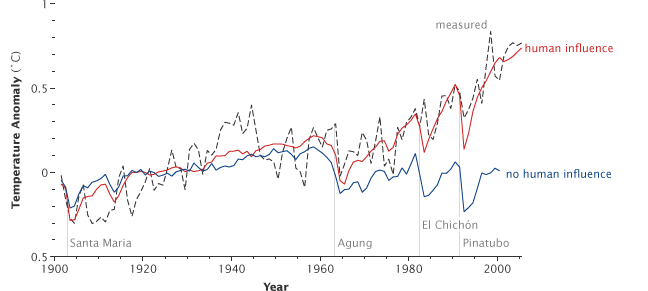The first piece of evidence that the warming over the past few decades isn’t part of a natural cycle is how fast the change is happening. The biggest temperature swings our planet has experienced in the past million years are the ice ages. Based on a combination of paleoclimate data and models, scientists estimate that when ice ages have ended in the past, it has taken about 5,000 years for the planet to warm between 4 and 7 degrees Celsius. The warming of the past century—0.7 degrees Celsius—is roughly eight times faster than the ice-age-recovery warming on average.
The second reason that scientists think the current warming is not from natural influences is that, over the past century, scientists from all over the world have been collecting data on natural factors that influence climate—things like changes in the Sun’s brightness, major volcanic eruptions, and cycles such as El Niño and the Pacific Decadal Oscillation. These observations have failed to show any long-term changes that could fully account for the recent, rapid warming of Earth’s temperature.

Finally, scientists know that carbon dioxide is a greenhouse gas and that it is released into the air when coal and other fossil fuels burn. Paleoclimate data show that atmospheric carbon dioxide levels are higher than they have been in the past 800,000 years. There is no plausible explanation for why such high levels of carbon dioxide would not cause the planet to warm.

-
References
- Hegerl, G. C., Zwiers, F. W., Braconnot, P., Gillett, N. P., Luo, Y., Orsini, J. A., Nicholls, N., et al. (2007). Chapter 9: Understanding and attributing climate change. In Climate Change 2007: The Physical Science Basis. Contribution of Working Group I to the Fourth Assessment Report of the Intergovernmental Panel on Climate Change. [Solomon, S., Qin, D., Manning, M., Chen, Z., Marquis, M., Averyt, K.B. , Tignor, M., and Miller, H.L. (eds.)] Cambridge and New York: Cambridge University Press.
- Jansen, E., Overpeck, J., Briffa, K.R. , Duplessy, J.-C , Joos, F., Masson-Delmotte, V., Olgao, D., et al. (2007). Chapter 6: Paleoclimate. In Climate Change 2007: The Physical Science Basis. Contribution of Working Group I to the Fourth Assessment Report of the Intergovernmental Panel on Climate Change. [Solomon, S., Qin, D., Manning, M., Chen, Z., Marquis, M., Averyt, K.B. , Tignor, M., and Miller, H.L. (eds.)] Cambridge and New York: Cambridge University Press.
- Lean, J. L., & Rind, D. H. (2008). How natural and anthropogenic influences alter global and regional surface temperatures: 1889 to 2006. Geophysical Research Letters, 35(18).
- Lockwood, M., & Fröhlich, C. (2008). Recent oppositely directed trends in solar climate forcings and the global mean surface air temperature. II. Different reconstructions of the total solar irradiance variation and dependence on response time scale. Proceedings of the Royal Society A: Mathematical, Physical and Engineering Sciences, 464(2094), 1367-1385.
- Lüthi, D., Le Floch, M., Bereiter, B., Blunier, T., Barnola, J., Siegenthaler, U., Raynaud, D., et al. (2008). High-resolution carbon dioxide concentration record 650,000–800,000 years before present. Nature, 453(7193), 379-382. [Download 800,000-Year CO2 Data]
- Steele, L. P., Krummel, P. B., & Langenfelds, R. L. (2007). Atmospheric CO2 concentrations from sites in the CSIRO Atmospheric Research GASLAB air sampling network (August 2007 version). In Trends: A Compendium of Data on Global Change, Carbon Dioxide Information Analysis Center, Oak Ridge National Laboratory, US Department of Energy, Oak Ridge, TN, USA.



